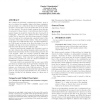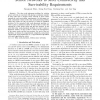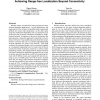370 search results - page 19 / 74 » Improved Approximation Algorithms for Connected Sensor Cover |
SIAMCOMP
1998
13 years 7 months ago
1998
This paper introduces a near-linear time sequential algorithm for constructing a sparse neighborhood cover. This implies analogous improvements (from quadratic to near-linear time)...
COMPGEOM
2009
ACM
14 years 1 months ago
2009
ACM
We consider the following combinatorial problem: given a set of n objects (for example, disks in the plane, triangles), and an integer L ≥ 1, what is the size of the smallest su...
INFOCOM
2008
IEEE
14 years 1 months ago
2008
IEEE
— The relay node placement problem for wireless sensor networks is concerned with placing a minimum number of relay nodes into a wireless sensor network to meet certain connectiv...
SENSYS
2009
ACM
14 years 2 months ago
2009
ACM
Wireless sensor networks have been proposed for many location-dependent applications. In such applications, the requirement of low system cost prohibits many range-based methods f...
ISAAC
2007
Springer
14 years 1 months ago
2007
Springer
The class of graphs where the size of a minimum vertex cover equals that of a maximum matching is known as K¨onig-Egerv´ary graphs. K¨onig-Egerv´ary graphs have been studied ex...



